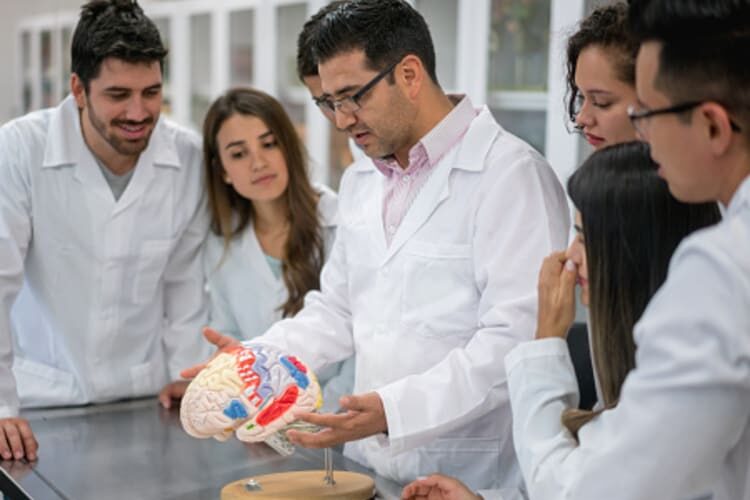If you have a passion for science and an analytical mind, you might consider a career in neuroscience. From discovering proteins that are essential for athletic performance to implanting tiny brain chips into the brains of paralyzed people to allow them to use computers, neuroscientists are making great strides forward every year for the betterment of humanity.
What is a Neuroscientist?
Neuroscience is the study of the nervous system, which includes the brain. Neuroscientists explore the biological and chemical processes that occur in the brain. These professionals are usually medical scientists who may study everything from brain development to the treatment of brain tumors to the diagnosis of dementia. Some neuroscientists are also medical doctors who work directly with patients.
Psychology is the study of human thoughts and behaviors. Psychology professionals study topics such as the development of language and the treatment of depression, and overlap between Psychology and Neuroscience can be extensive. Either path can be a route to a neuroscience career.
What do Neuroscientists do?
A neuroscientist is a lifelong learner who continually strives to increase the body of knowledge in the field. These professionals typically work in academia, such as within research facilities and teaching hospitals, but they may also work in the for-profit, nonprofit, and governmental sectors. Some neuroscientists spend much of their time in the lab or the office, while others work in clinics to provide direct patient care.
The daily tasks of a neuroscientist heavily depend on the work setting and employer. In general, however, these scientists may do any of the following in their quest to learn more about the nervous system:
Design scientific experiments and develop hypotheses
Prepare cell and tissue samples
Use advanced lab equipment to analyze samples and monitor brain activity
Use sophisticated computer software to create models and simulations of the nervous system
A neuroscientist may also spend much of their time finding funding opportunities and writing grant proposals to keep their lab funded. Neuroscientists stay on top of the latest developments and research in their field by reading academic journals and research papers. They also publish their own research in such journals.
What Is Cognitive Neuroscience?
Cognitive neuroscience is a specialty within the neuroscience field. This subfield focuses on the biological processes that support or facilitate cognition. In particular, cognitive neuroscientists study the relationships between the structures of the brain and their activity or cognitive functions.
Neuroscientists who choose to focus on this subfield have the most overlap with the psychology field. Some students might even choose to earn a dual degree in biology or neuroscience with psychology.
Are there other subfields of Neuroscience?
There are many subfields of neuroscience that students may wish to consider focusing on. In addition to cognitive neuroscience, the following are common specialties:
Developmental neuroscience – Focuses on how the brain forms, develops and changes
Molecular and cellular neuroscience – Explores the molecules (proteins, genes, etc.) that dictate the function of neurons and other brain cells
Clinical neuroscience – Explores the prevention, diagnosis and treatment of neurological disorders and injuries (e.g. brain tumors)
Neurogenetics – Focuses on inherited diseases that affect neurons, such as Huntington’s disease
Neurophysiology – Studies the nervous system and its functions
Sensory neuroscience – Evaluates the body’s sensory systems, including how the nervous system processes sensory information
As you can see, there are many subfields in which to consider specializing when you choose a career in neuroscience. However, you don’t need to choose a subfield right away. You might not know exactly where your interests lie until you begin pursuing your graduate education.
How to become a Neuroscientist
The process of becoming a neuroscientist is quite lengthy and rigorous. It is a meaningful and rewarding line of work, yet you must be certain that you can commit to many long years of hard study and research. However, if you’re still in high school, you don’t need to decide right away.
You can begin taking high school courses that support a future career in neuroscience, such as Advanced Placement (AP) biology and chemistry, as well as advanced mathematics classes like pre-calculus. These courses will be useful to you even if you ultimately decide that your career lies in a different STEM field. Don’t neglect the humanities either, as scientists must be able to clearly communicate their research and analyses verbally and in writing.
The journey to become a neuroscientist will begin to pick up speed after high school. You’ll need to earn a bachelor’s degree and then a master’s degree and/or a Doctor of Philosophy (PhD). If you intend on working with patients, you will need to earn a degree from medical school and a physician’s license.
After earning your doctoral degree, you’ll complete one or more postdoctoral programmes. These are research-intensive positions that sometimes also involve teaching. After your time as a postdoc, you’ll be able to compete for advanced positions in the field, such as the opportunity to direct your own laboratory.
Are Neuroscientists in high demand?
All types of medical professionals, including scientists like neuroscientists, are expected to be in high demand for the foreseeable future.





